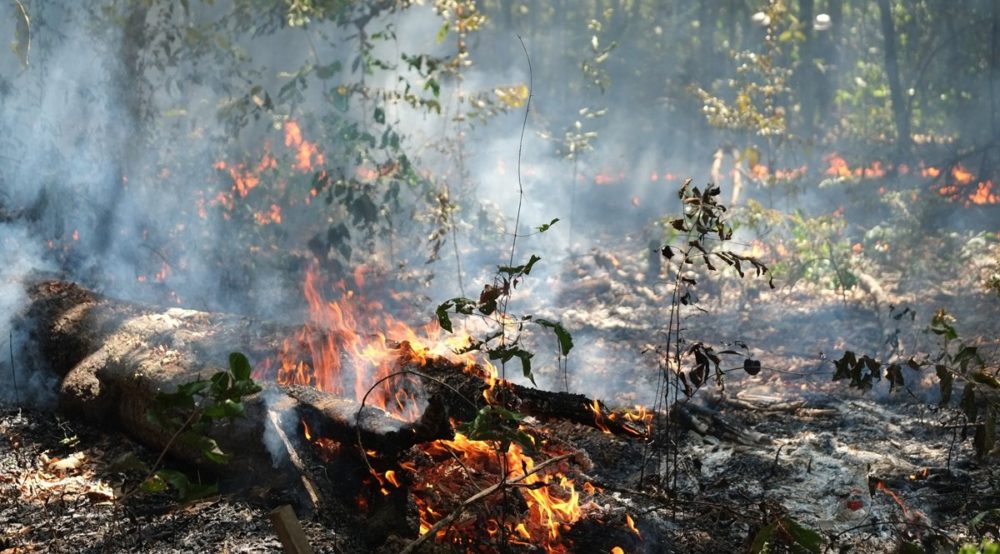In Brazil, deforestation in the Amazon has been compared to a starved dragon. However, this dragon has been under control in the past. Deforestation in the region declined 70% from 2005 (19,014 km2) to 2014 (5,012 km2) in response to different strategies described in the literature. But the monster was not killed, it was just taking a nap. Since 2012, the annual rate of deforestation has stayed at around 5,000 km2 (4,571 km2 in 2012, 5,891 km2 in 2013, 5,012 km2 in 2014 and 6,207 km2 in 2015), according to data from the PRODES 2016 database. Unfortunately, in 2016 the sleepy dragon woke up. On November 29, the Brazilian government released data on deforestation in 2016 showing that an area of forest equivalent to 10 times the size of the New York City (7,989 km2) was devastated (Figure 1). This figure is the highest since 2008, when deforestation hit 12,911 km2, possibly indicating a return to the old pattern of deforestation.

Figure 1: Amazon deforestation rates evolution from 2015-2016. (Source: PRODES 2016)
The Amazon states of Pará, Mato Grosso, and Rondônia are again the main states to have lost forest cover. Jointly they account for 75% of all deforestation as measured by PRODES, the official monitoring system operated by the Brazilian Space Agency (INPE). The surprise, however, came from the State of Amazonas, which contains huge preserved forests. Since 2014, deforestation rates there have been on the rise, and in 2016, totalled above a 100% accumulated increase (Figure 1).

Photo: Agência NaLata
The sad message Brazil is giving to the world with 2016’s startling new deforestation rate is that its impetus to control deforestation may be waning. The country was already ranked the fourth largest producer of greenhouse gases in the world in 2007 due to emissions from forest destruction in the Amazon. It is a past that we simply cannot return to in order to avoid putting the climatic balance of a significant portion of national territory at risk. Deforestation can bring severe consequences for agricultural production that accounts for a large part of Brazilian GDP, as shown by scientific studies in the Xingu region.
In addition to risks posed to the local and regional climate, the new deforestation rate threatens to discredit Brazil before the international community, given that the government announced its emission reduction targets from deforestation (to stop illegal deforestation only by 2030) under the Paris Agreement signed by the UN Framework Convention on Climate Change. Brazil also announced in 2009 that it would reduce deforestation in the Amazon 80% by 2020, promising that the rate for that year would be 3,925 km2. With the recent increase to almost 8,000 km2, the effort required to reach that target will be far more challenging. That is, to reduce that rate by 50% in the next four years.
On the other hand, Brazil has all the elements needed to reverse this new frightening trend. The paths to extinguishing deforestation in the Amazon are already known, as recently showed by studies published in the scientific journal Elementa: Science of the Anthropocene. For example, full implementation of the Forest Code (the legislation protecting forests), the allocation of public forest as protected areas, and positive incentives to those conserving forest are put forth as the most crucial paths to zeroing out deforestation in the region.
Also, the Amazon contains extensive areas that have already been deforested and are available for agriculture and improved efficiency in livestock rearing. In addition, a significant portion of the private sector already recognizes the importance to keep their supply chains free of deforestation (the soy moratorium, for example). So a strong response from all Brazilian sectors – including the private sector – is needed to reverse this emerging trend of increasing deforestation rates. Otherwise, the country’s capacity to control destruction of the largest forest on the planet will, undoubtedly, be greatly hampered. We need to produce more, export more, and create more economic benefits for our population, but not at the expense of future generations.

